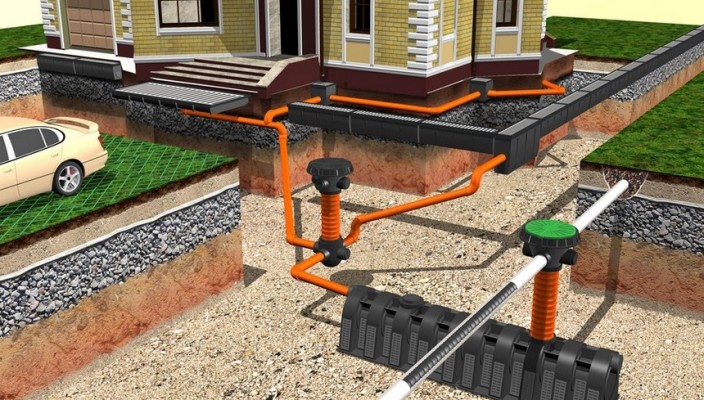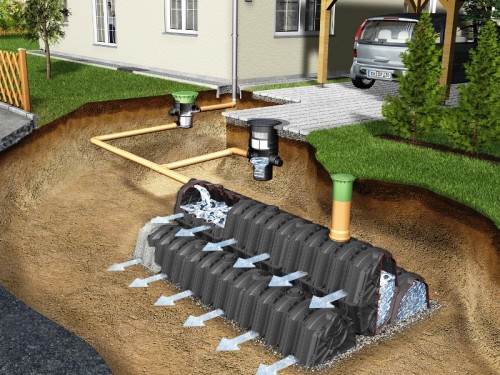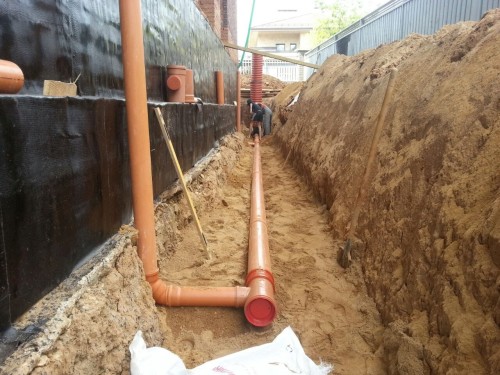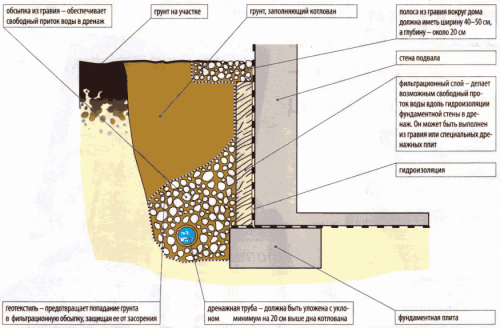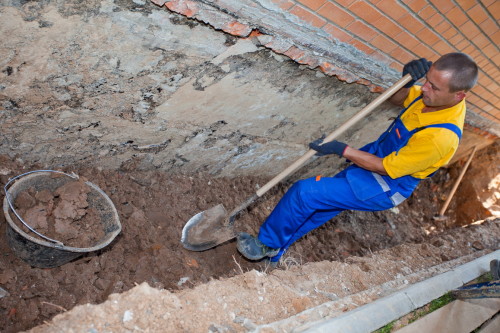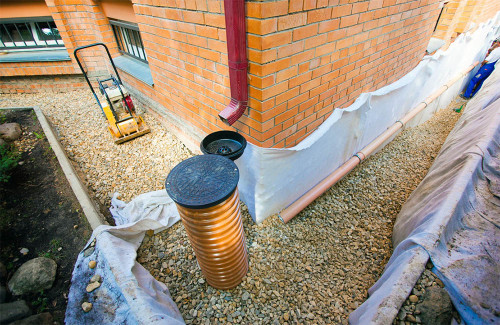To extend the service life of the foundation of the house (and, accordingly, the structure itself) will need to take off the excess moisture. This is especially true for the autumn-spring season, when the maximum amount of precipitation occurs. In our article we will talk about how to make a drainage system.
Content
System Design
In order for the work of the drainage system to be as efficient, a number of nuances should be taken into account. At the initial stage, you need to get information:
- about the soil composition on the site where house-building is located;
- on the depth of the groundwater;
- on the presence of other water sources.
In the presence of weak soil, additional strengthening of the walls of the drainage trench will be required. If the drainage system device occurs directly near the foundation, then it is necessary to make a padding around the house to determine the depth of its bookmark.
After a thorough study of the above factors, a drainage plan is drawn up and materials for the drainage system are purchased.
The drainage bookmark is carried out with regard to:
- distances between drainami;
- the depths of their location.
The maximum step of laying drain is:
- for sandy soil - 50 m;
- for Suglinkov - 20 m;
- for soil with high clay content - 10 m.
For more efficient and fleeting drying, the drain section is placed as a short distance from each other.
If the drainage system around the house is laid during its construction, the most appropriate solution will be the device of a multifunctional drainage system. It will consist of:
- superficial drainage;
- underground storm sewage;
- wounded drainage.
One of the main elements of the drainage system are pipes. The magnitude of the diameter of the used pipes has a direct impact on the time of removal of water flows and an indicator of the DRAN slope.
Drainage varieties
Drainage systems are:
- superficial;
- deep.
In turn, the surface drainage can be point and linear, and the deep - wall-wired and ring.
Drainage point system
This type of drainage is designed for rapid drainage from the soil located at home. Installation of a point drainage system of the house is carried out:
- under the doors;
- under drainage;
- at the corners of the building.
By itself, this type of drainage is ineffective when falling out too much precipitation. For this reason, the point system is complemented by linear drainage.
Linear drainage
It consists of swallowed channels, in which leaves and other small garbage will be removed with water flows. This drainage system is necessarily equipped with sand-trap, thanks to which the washed sand is not accumulated in the drainage.
In most cases, linear drainage consists of concrete / plastic drainage and trays, cast-iron lattices and plastic water reservoirs. Some systems include and a basket in which garbage will accumulate.
Wasted drainage
During the construction of a drainage system of this type, it is not worried not only about the negative impact on the foundation of the shower structure. Wailed drainage also protects against the influence of groundwater when they are asked to the maximum level. What is a big plus in the device of basement and basement rooms.
A wall-willed system consists of pipes and inspection wells. Laying pipes is made near the foundation below the level of the base of the house. Naturally, the pipes are mounted under the slope so that the water fall into the wells. From the wells water goes beyond the boundaries of the site.
Ring drainage
The principle of creating a given drainage system is largely similar to the technology of the device for a used drainage. The only difference is that it disappears the need to dig a trench at the foundation itself. It is riveted in 2.5-3 m from the base of the house.
If the foundation of the building is protected with a used drainage system, then the annular drainage is not necessary to create.
Preparatory stage
Ideal when the drainage system device begins in advance. For example, in the spring, when it rains. At this time it is easy to define places where water accumulates in maximum amount. It is the places that will become a reference point for creating a drainage well to which under a slope (2-30 mm per 1 m) pipes will be stretching.
At the preparatory stage, such works are carried out:
- digging trenches around the perimeter of the house (at a distance of 0.8-1 m from the foundation);
- purification of the base of the structure from the soil and the old waterproofing material;
- drying the foundation (in the absence of sunny days, you can use the gas burner);
- coating the base of the house with new waterproofing (better than bituminous material);
- outlet of waterproofing with a small amount of gravel.
The width of the trench should exceed the diameter of the pipes by 20-25 cm, the depth is the lower point of the foundation of the house by 50-60 cm.
In the area where rains are quite frequent, before carrying out installation work, you must create a canopy over the trenches. This uses boards on which the reinforced film from polyethylene is attached.
A few words about pipes. Several years ago, ceramic or asbestos-cement products were used. When you create a Drainage System of the Private House with your own hands, preference is better to give to plastic pipes, to install which will not need significant effort.
Moreover, special corrugated products with perforation are sold. And some pipes are turned off with nonwoven material, due to which excessively preventing the system is prevented.
Surface drainage device
To create a given variety of drainage system, it is necessary:
- pour concrete bottom of the trench;
- carry out the laying of channels that are attached by concrete slopes;
- the cutting of the channels to be carried out in such a way that the upper part of the lattice is 4-5 mm below the finish ground coating;
- set sand catcher, which are a reference point for creating a drain channel;
- connect sandowers with pipes (used PVC nozzles).
It is not necessary to carry out additional sealing of the joints, since the channels are joined using a sheet and grooves. After mounting, the sandwalker should be removed the cap, which is located in the outlet of the housing.
Creating a deep drainage
Although the installation of the drainage system of this type is a longer process, it is of greater efficiency in the tap of storm flows.
The bottom of the trench is maximally compacted. To do this, a 10-centimeter sandy pillow is created, which is thoroughly tamped. After that, it is produced:
- installation of geotextile (its edges must be tested);
- floating a large rubble;
- installation of pipes;
- laying another layer of rubble (10-15 cm);
- the compound of both ends of geotextiles (can be sewn);
- failure of the Earth with the creation of a small hill.
When laying pipes, a bias is necessarily observed to that part of the site where the water receiver will be located. The pipe connection occurs with the help of fittings that are tightly fixed using a fum-ribbon or tape.
During the installation of the drainage system, take care of the correct location of the water reservation. It can be made of any plastic container. The container is placed in the ground to a depth, which exceeds the laying level of pipes by 1-1.2 m.
On the bottom of the pit, where the water reservation is planned to install, geotextiles are laid. For reliable fixation, the container is attached to the bottom by drilling holes in it under long pins, which are buried in the ground. A pit with a container is covered with rubble and earth.
Some Soviets
In order for the device of the drainage system to produce qualitatively and subsequently remake it, it is necessary to take into account such nuances:
- If there is time, then after digging the trench you need to wait for the rain rain. After his passage in properly dug trenches, water will not accumulate.
- It is forbidden to use limestone rubble. If there is no possibility to purchase crushed stone, then it can be replaced by a broken brick.
- The diameter of the holes in pipes for perforation should not exceed the size of the rubble.
- The use of geotextiles is mandatory in the presence of clay soil. The material should be well to skip and filter water streams. It is not recommended to use dense needle-free textiles.
- Drainage wells can be both cumulative and absorbing. The first to have a hermetic bottom. They are going to water intended for watering a plot. In absorbing wells, water will go into the soil.
Video of the drainage system device:

